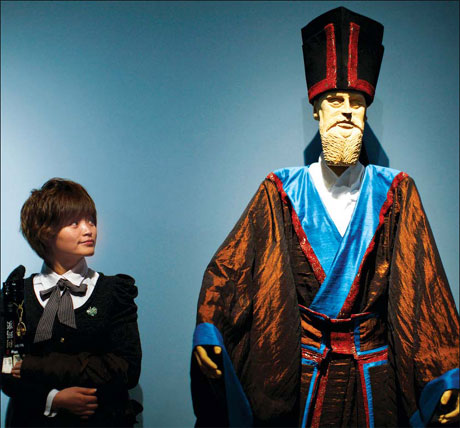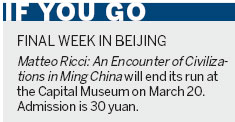


2010 marks the 400th anniversary of the death of Matteo Ricci, an Italian missionary who introduced Western culture, art and science to China during the Ming dynasty. Ricci was a valued advisor to the Chinese court as well as the first foreigner buried in the imperial capital when he died in 1610.
The Capital Museum of China in Beijing currently has an exhibit, Matteo Ricci: An Encounter of Civilizations in Ming China, celebrating the missionary and displaying 72 Italian artworks and relics, and 62 Chinese artifacts from the Ming Dynasty (1368-1644).
The works featured create a historical journey beginning in Macerata, a city in the Italian region of Marche where Ricci was born in 1552.
In 1571, after studying law in Rome, he joined the Society of Jesus, studying at the Collegio Romano, where his teacher was the famous mathematician Christophe Clavius. Less than a decade later, he embarked on a mission that would eventually end in China.
The first portion of the exhibit, curated by Filippo Mignini, highlights the dominant art and culture of Western Europe during the 15th and 16th centuries. There are paintings from Italian Renaissance greats, including masterpieces by Raphael, Titian and Lotto Barocci, which are on display in China for the first time.

The paintings and tapestries are followed by other late Renaissance artifacts emblematic of the European zeitgeist Ricci introduced to Chinese intellectuals: ornate sundials, Italian armor, models of ancient Roman architecture, (Ricci built the first European home in China in the city of Zhaoqing), and manuscripts from prominent philosophers, scientists and mathematicians of the era.
"The Chinese literati could not believe their eyes when they saw Western books, which showed there was a society of cultured people outside China," reads one exhibition panel describing China's reception of European knowledge.
The second part of the exhibit displays the culture of China when he arrived. Featured are gold and jade objects reflecting fascination with Emperor Wanli of Ming Dynasty's court as well as works created by Ricci in conjunction with Chinese intellectuals, maps and scientific instruments (Ricci composed the first European-style map of the world in Chinese).
The exhibition gives an eye-opening glance at the vast array of cultural exchange facilitated by Ricci and offers a glimpse of how globalization worked in a different era.
The Ricci exhibit will leave the Capital Museum on March 20 and visit Shanghai in April and Nanjing in June. Admission is 30 yuan.